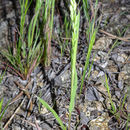pt-BR
nomes no trilho de navegação


Poa bigelovii is a species of grass known by the common name Bigelow's bluegrass. It is native to the southwestern United States and northwestern Mexico, where it grows in shady spots in desert and plateau habitat.
It is an annual bunchgrass growing in small clumps up to 40 centimeters tall. The inflorescence is a narrow, compact, cylindrical series of hairy spikelets. The spikelets sometimes have a curly tuft of hairs or cobwebby fibers near their bases.
Poa bigelovii is a species of grass known by the common name Bigelow's bluegrass. It is native to the southwestern United States and northwestern Mexico, where it grows in shady spots in desert and plateau habitat.
It is an annual bunchgrass growing in small clumps up to 40 centimeters tall. The inflorescence is a narrow, compact, cylindrical series of hairy spikelets. The spikelets sometimes have a curly tuft of hairs or cobwebby fibers near their bases.
Poa bigelovii, es una especie botánica de pastos de la subfamilia Pooideae. Es originaria del sudoeste de los Estados Unidos y noroeste de México, donde crece en lugares con sombra en el desierto y el hábitat de la meseta.
Es una planta anual con panojas que crece en pequeños grupos, alcanzando un tamaño de hasta 40 centímetros de altura. La inflorescencia es angosta, compacta con espiguillas velludas. Las espiguillas tienen a veces un mechón de pelos rizados o fibras en forma de telaraña cerca de sus bases.
Poa bigelovii fue descrita por Vasey & Scribn. y publicado en A Descriptive Catalogue of the Grasses of the United States 81. 1885.[1]
Poa: nombre genérico derivado del griego poa = (hierba, sobre todo como forraje).[2]
bigelovii: epíteto
Poa bigelovii, es una especie botánica de pastos de la subfamilia Pooideae. Es originaria del sudoeste de los Estados Unidos y noroeste de México, donde crece en lugares con sombra en el desierto y el hábitat de la meseta.
Poa bigelovii là một loài cỏ trong họ hòa thảo, thuộc chi poa.[1]